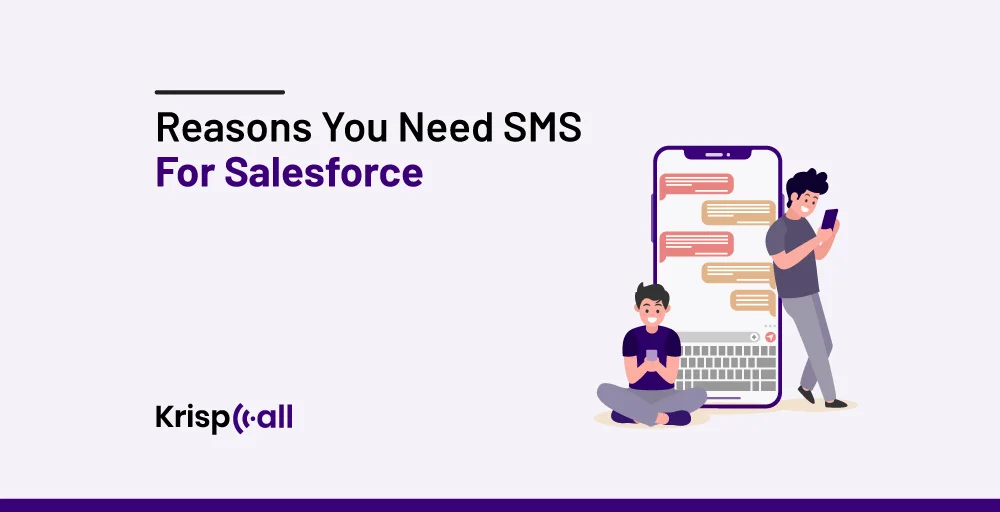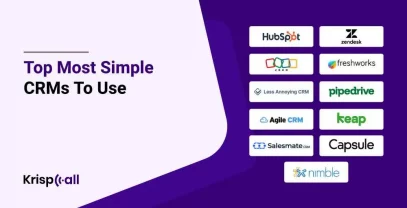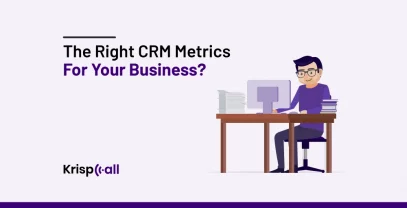In today’s digital world, capturing your customers’ attention is becoming increasingly challenging. Traditional communication channels like phone calls and emails are often ignored, making it difficult to connect with your prospects and customers effectively.
Failing to reach your customers can result in missed opportunities to build relationships, share valuable information, and drive sales. This can negatively impact your sales pipeline, team productivity, and morale.
Integrating SMS into your Salesforce platform opens up a new channel for customer engagement. SMS features in Salesforce offer several key benefits that can transform your sales strategy and drive better results.
In this blog, we will explore why SMS for Salesforce is indispensable, highlight its benefits and use cases, and share best practices for implementing SMS in Salesforce.
🔑 KEY HIGHLIGHTS
- The five reasons you need SMS for Salesforce include instant and real-time communication, enhanced efficiency through automation, higher open rates, personalized messages tailored to individual needs, and easy tracking.
- In Salesforce workflows, texting enhances sales and marketing activities, such as appointment reminders, follow-ups, lead nurturing, event promotions, ticket sales, etc.
- Best practices for implementing Salesforce texting include obtaining consent, personalizing messages, keeping them concise, strategic automation, performance monitoring, compliance adherence, etc.
5 Reasons You Need SMS for Salesforce
SMS for Salesforce has numerous benefits and can significantly enhance your business operations. The main reason for this integration is its unparalleled efficiency and effectiveness in customer interactions.
Here are five reasons why integrating SMS into Salesforce can be beneficial:
1. Instant and Real-Time Communication
By using SMS for Salesforce, companies can provide instant customer support. For instance, logistics companies can promptly notify customers of delivery locations via SMS, ensuring timely updates. They can also send immediate appointment updates via SMS, keeping clients well-informed throughout their customer journey.
Similarly, SMS boasts a very high open rate (over 95% within 3 minutes). This high open rate makes SMS a powerful tool for enhancing engagement in marketing strategies than emails using Salesforce.
2. Increased Efficiency with Workflow Automation
Integrating SMS with Salesforce streamlines workflow automation by automating tasks such as appointment reminders and order updates. This reduces manual efforts, enhancing overall efficiency. Businesses can then focus on strategic activities rather than routine tasks.
In addition, it lets you trigger texts based on customer behavior or sales stages, streamlining workflow to maximize productivity.
3. Higher Open Rates and Response Rates
Text messages have a response rate of about 45%, which is much better than other ways of reaching people. They’re short and get to people right away, which makes them great for getting responses. This helps sales and marketing teams engage effectively with their audience.
For example, retail stores can quickly send SMS with discount codes to attract immediate customer responses. They can also use SMS for urgent messages to ensure fast and effective customer communication.
4. Personalized Messages Tailored to Individual Customers
Integrating SMS with Salesforce empowers businesses to personalize messages. They can compose messages that resonate with recipients’ unique needs and pain points, which is important for making a strong connection and gaining more conversions.
For instance, a travel agency can deliver customized travel recommendations based on previous bookings. Likewise, financial advisors can offer personalized investment updates and tips via SMS, addressing individual client interests in depth. Overall, SMS in Salesforce helps boost customer satisfaction and loyalty.
5. Tracking and Analytics
Another reason for Salesforce’s need for SMS is its ability to track and analyze campaign effectiveness and customer engagement. The integration of SMS into Salesforce allows marketing teams to analyze open rates, click-through rates, and conversions from SMS campaigns to refine messaging strategies.
Additionally, customer support teams can evaluate response times and resolution rates from SMS interactions to improve service efficiency and enhance customer satisfaction throughout their journey.
Use Cases and Examples of SMS in Salesforce
SMS in Salesforce can boost sales and marketing efforts. It’s versatile in various ways.
Here are some examples of how SMS can be effective in Salesforce:
- Appointment reminders and confirmations: For service-oriented businesses, Salesforce SMS features help send appointment reminders and confirmations, ensuring they get timely notifications before their appointments. This automated system reduces no-shows and improves the company’s efficiency by minimizing scheduling gaps.
- Sales follow-ups and lead nurturing: Using Salesforce, businesses can effectively follow-ups to ensure timely and personalized communication with leads. This keeps leads interested and builds trust. For example, a real estate agent can send property listings and updates to potential buyers. Plus, by analyzing interaction data, sales teams can focus on the most promising leads.
- Event promotions and ticket sales: SMS-based event promotions, such as webinars, conferences, and concerts, can boost engagement. Including direct links to purchase tickets further improves the customer experience. Also, SMS Salesforce integration lets organizers track responses and optimize marketing efforts based on real-time data, enhancing outreach effectiveness and ensuring a smooth ticket-purchasing experience.
- Customer support and feedback: Customer support teams use SMS features in Salesforce to send automated SMS surveys for feedback after resolving inquiries. For instance, a telecommunications company might send satisfaction surveys via SMS after solving technical support issues. This proactive approach improves customer satisfaction and provides valuable insights for service improvements.
- Internal notifications: Team members receive automated SMS alerts for tasks and updates through Salesforce, ensuring timely notifications. For example, a project manager can send the team deadline reminders and meeting alerts, improving productivity and coordination. This integration streamlines communication and keeps the team informed, facilitating efficient task management and project execution.
Best Practices for Implementing SMS in Salesforce
To get the most out of SMS in your Salesforce workflow, you need to follow a few best practices. These include:
- Choose SMS Provider: You should select a reliable SMS service provider that integrates seamlessly with Salesforce, such as Twilio or MessageMedia.
- Install AppExchange Package: You can simplify the setup process by installing a pre-built SMS integration package from Salesforce AppExchange. For instance, installing the “Twilio for Salesforce” package enables easy configuration and management of SMS communications.
- Set up API: You can enter the SMS provider’s API within Salesforce to enable the system to send and receive messages. For example, entering API keys and endpoint URLs from Twilio into Salesforce settings allows message flow platforms.
- Create SMS templates: You should design reusable SMS templates to maintain consistency and save time on frequently sent messages. For example, creating a template for appointment reminders ensures uniform messaging and reduces manual effort.
- Use process builder: You need to automate sending SMS messages by setting up workflows in Salesforce Process Builder. For example, you can create a process that automatically sends a welcome SMS to new leads.
- Monitor Usage: You should also regularly review SMS usage metrics and costs to manage budget and resource allocation effectively. Analyzing monthly SMS volume can help optimize spending and prevent overuse.
- Keep messages short and sweet: Make sure your SMS messages are clear, engaging, and easy to act on. Consider character limits and include clear calls-to-action (CTAs) that tell recipients what to do next.
Conclusion
In a world where every interaction matters, reaching out to customers via their text messages is crucial.
The combination of SMS and Salesforce brings numerous benefits for businesses. It supports personalized lead nurturing and efficient customer service, offering diverse and impactful applications. Plus, it enables automated notifications, reminders, and follow-ups within Salesforce, improving productivity and reducing manual effort.
By adopting this powerful combination, you provide your teams with the necessary tools to thrive in a competitive market.





